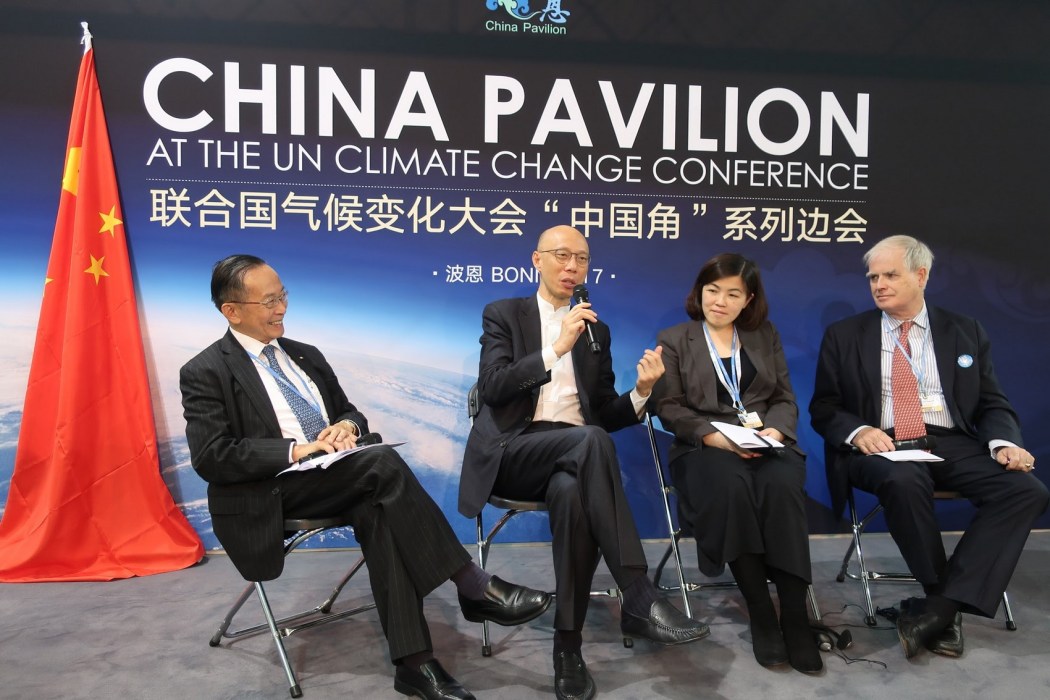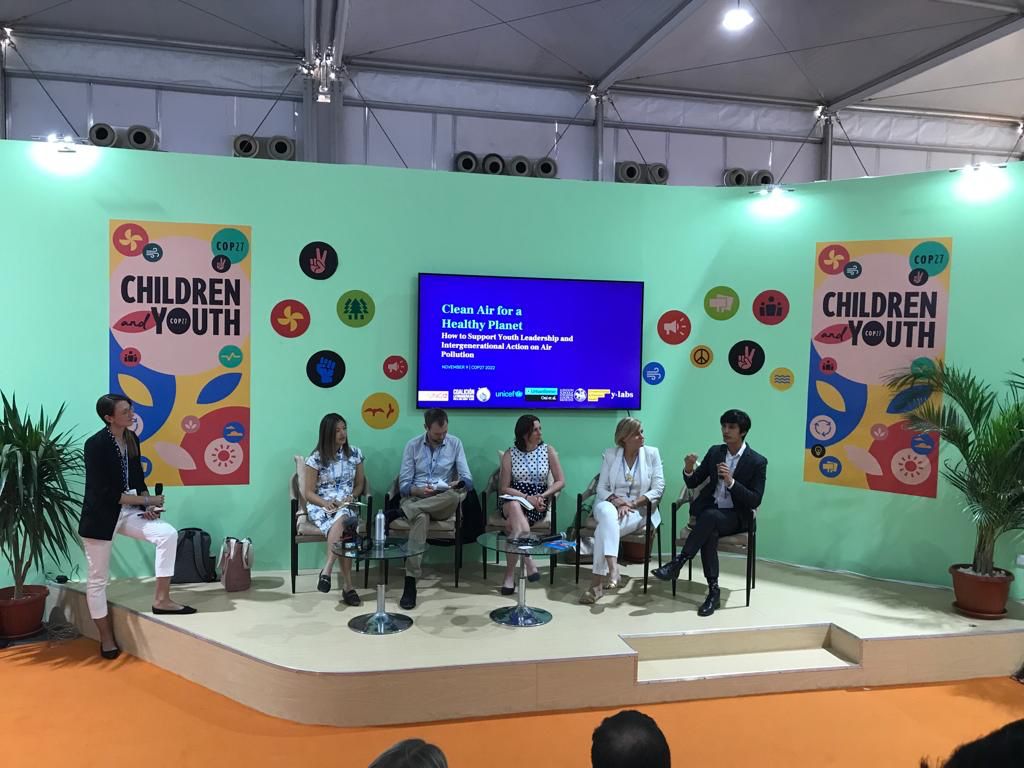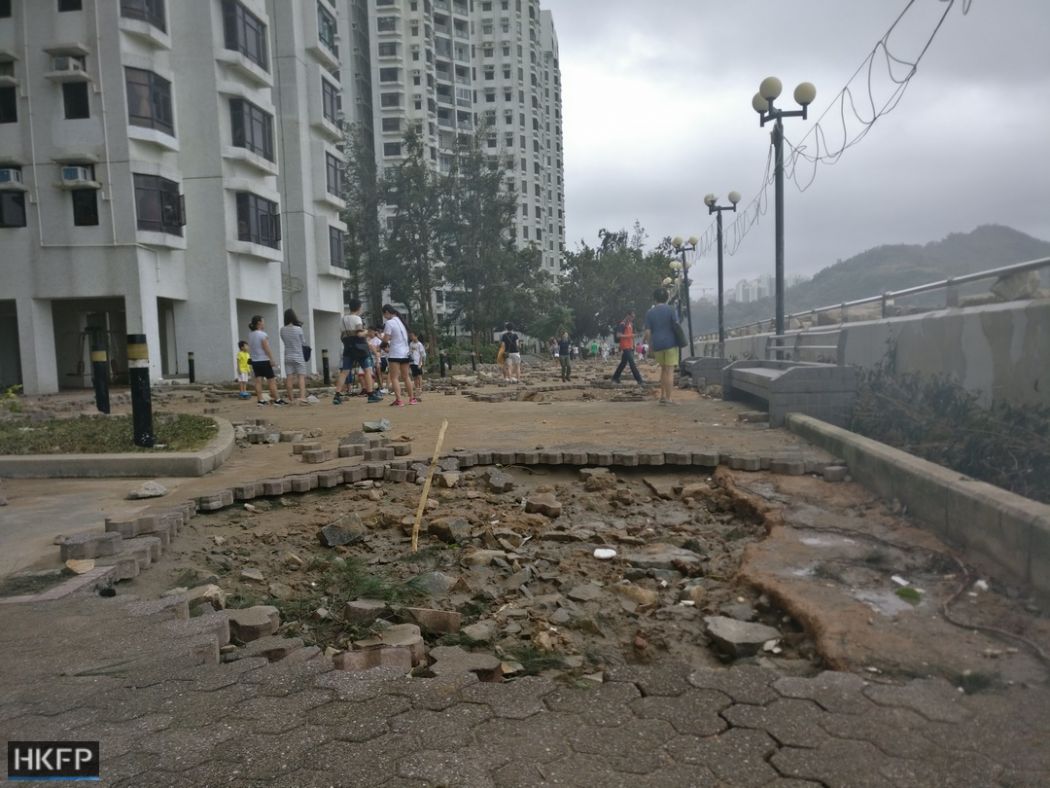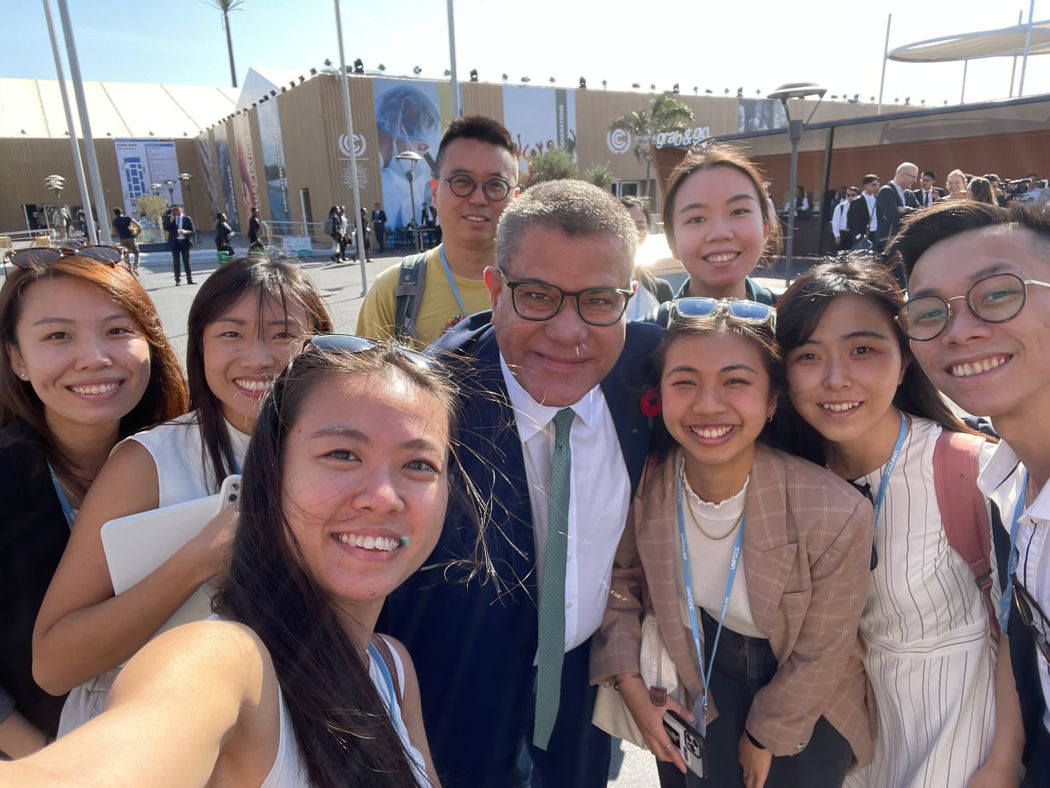When Super Typhoon Mangkhut barrelled into Hong Kong on September 17, 2018, its ferocious winds and record-breaking storm surge uprooted some 1,500 trees, caused countless window panes to shatter, left hundreds injured and devastated coastal communities. It also awoke many residents to the reality of the climate crisis.

Environmental advocates point to the extreme weather event – the direct economic loss from which was estimated to have cost the city HK$4.6 billion – as a turning point in attitudes.
“People are more aware of the climate crisis these past few years. Especially after the 2018 super typhoon,” Tom Ng, a campaigner with Greenpeace, told HKFP. “That is the first step; that people are aware and acknowledge that the issue is affecting them,” Hg said.
However, “it is still not enough.”
‘Disappointed’ by gov’t absence
At the Egyptian Red Sea resort of Sharm el-Sheikh – which for the past two weeks has played host to world leaders, international media, business and banking executives, as well as key climate stakeholders – a group of young Hongkongers has been working to try and make sure more is done to further the city’s climate agenda.

Attending the 27th session of the Conference of Parties (COP27) of the UN Framework Convention of Climate Change (UNFCCC) were Judy Cheung, 30, Chin Chin Lam, 26, and Ryan Yip, 22. They formed part of a youth delegation with Hong Kong-based NGO CarbonCare InnoLab (CCIL), in the absence of any officials representing the city.
“Frankly speaking, we are quite disappointed with the fact that the Hong Kong government does not treasure the opportunity to participate in COP”
CarbonCare InnoLab’s Kwok Hui Chung
The last time the Hong Kong government sent someone to the annual climate summit was in 2017, when then-environment secretary Wong Kam-sing joined the Chinese delegation at COP23 in Bonn, Germany.
According to a statement, while hosting a Hong Kong session at the China Pavilion, Wong said the climate crisis was “a cross-sector, cross-domain subject which has far-reaching socio-economic and cultural impacts across the globe.” As “a member of the global village,” Hong Kong must “contribute proactively” to combating climate change, Wong added.
Ever since, however, this member of the global village has been absent, whilst the city’s new leader John Lee had little to offer in terms of environmental commitments in his inaugural Policy Address.

“Frankly speaking, we are quite disappointed with the fact that the Hong Kong government does not treasure the opportunity to participate in COP,” Kwok Hui Chung, CCIL’s senior programme officer, told HKFP by phone from Sharm el-Sheikh.
Hong Kong is not a party to the UNFCCC, but it has set its own target of achieving carbon neutrality by 2050. “We believe that, as a city, Hong Kong has a responsibility to reduce carbon emissions and keep 1.5 degrees alive,” Kwok said.
He was referring to the Paris Agreement, an international treaty negotiated at COP21 that outlined a commitment to keep the mean global temperature rise below 2 degrees Celsius, and preferably limit the increase to 1.5 degrees, thus reducing the effects of the climate crisis. China is among the 194 UNFCCC members that are signatories to the accord.

“As decided by the Central People’s Government, the Paris Agreement applies to the Hong Kong Special Administrative Region (SAR) as well,” a spokesperson from the Environment and Ecology Bureau told HKFP.
“Hong Kong is committed to the target of striving to achieve carbon neutrality before 2050 and reduce the total carbon emissions from the 2005 level by half before 2035,” they said. “We have been closely monitoring discussions at the COP conferences to assess the implications of the discussion outcomes on our climate actions.”
A question about the lack of official presence at this year’s event went unanswered, with the EEB spokesperson saying that Hong Kong had been present at COP21, when the Paris Agreement was adopted, “and the subsequent COPs.”

Last month, a report from the United Nations Environment Programme found that the world was falling well short of the goal set out in the Paris Agreement. Under current measures, temperatures could rise as much as 2.8 degrees by the end of the century.
Hong Kong warning signs
For Hong Kong, this would manifest in a number of ways. Pointing to an assessment conducted by the Hong Kong Observatory, Eva Yeung – senior manager of community resilience at the Hong Kong Red Cross (HKRC) – said the city “will experience climate change” in terms of rising temperatures and sea levels.
“We are a coastal city, there are a lot of coastal communities that may be severely impacted by future sea level rise but also storms or typhoons”
Chin Chin Lam, COP27 youth delegate
“The sea level has recorded an average rise of about 3 centimetres per decade in Hong Kong under the impact of global warming,” Yeung said. This has the greatest impact on low-lying and coastal regions, with the impact accelerated by typhoon-generated storm surges, Yeung added. Climate scientists agree that typhoons will become more frequent as the world heats up.
Residential complexes such as Heng Fa Chuen in Chai Wan are particularly vulnerable. The estate, home to more than 18,000 people, saw flooding in 2017 after being caught off guard by Typhoon Hato and was battered by Manghut the following year. Whenever the Hong Kong Observatory raises a storm signal, the media descends on the development to report from the frontlines of an extreme weather event.

“We are a coastal city, there are a lot of coastal communities that may be severely impacted by future sea level rise but also storms or typhoons,” said Chin Chin Lam, one of the CCIL youth delegates.
Speaking to HKFP from COP27, Lam said that Hongkongers were generally “comfortable, and they might not feel the immediate effects” of the climate crisis. However, climate extremes – such as the floods that submerged the South Korean capital Seoul in August, were warning signs for the city.
“Seoul is such a developed city, similar to Hong Kong… I think that serves as a bit of a wakeup call to Hongkongers,” Lam said. “As well as Typhoon Mangkhut and actually the November typhoon – what was that? When did we ever have typhoons in November? I think these things… are slowly creeping up on Hongkongers [to show] that climate change is real, it’s happening to us as well.”

A heatwave in July also highlighted how global heating affects Hong Kong, and how soaring temperatures disproportionately impact the city’s most vulnerable residents. “July was actually Hong Kong’s hottest month ever, breaking 11 weather records,” Yip said via a phone call from Sharm el-Sheikh. “I think climate change is really exacerbating the urban heat island effect in Hong Kong,” he added, referring to how human activity and urbanisation increases temperatures in cities.
Outdoor workers – typically those in low-income roles such as street cleaners, labourers and delivery drivers – experience the worst of this. Those living in substandard housing are also unduly impacted. “If you live in a [subdivided housing] unit, the temperature inside will feel on average 5 degrees Celsius higher than [the temperature] that is reported outside from the Hong Kong Observatory,” Lam said.
Ng from Greenpeace expanded on this, saying that residents of subdivided units often had no way of keeping cool. “A lot of [them] cannot afford to have a fan or air conditioning in their homes, because fans cost too much space and AC costs too much money,” Ng said.

The impact of 2.8 degree heating is not limited to Hong Kong, “it would affect food supply across the world,” Ng said. For a city that imports more than 90 per cent of everything it eats and drinks, that is not good news. When Covid-19 disrupted fresh produce deliveries from mainland China and sparked panic buying and inflated prices in February, it was the poorest households that were left with little to eat.
This, HKRC’s Yeung, said was indicative of how the climate crisis will impact Hongkongers: “People with limited resources will suffer more.”
‘We shouldn’t give up’
To reduce the impact of climate change, both globally and in Hong Kong, requires the involvement of the government, of businesses and of individuals, Ng said.

Greenpeace recently looked into government departments’ environmental reports to see what carbon reduction measures were in place and whether targets had been set to help Hong Kong achieve net-zero by 2050. What the organisation found, Ng said, was “not good.”
“A lot of them do not have their own carbon neutrality targets, and… their measures are just not really matching the goal of carbon neutrality,” he added, pointing to a lack of direction from the Environmental Protection Department (EPD). Guidelines on environmental performance reporting exist, but they were written in 1999 and have not been updated since.
“That creates some problems,” Ng said. “Twenty-three years ago, climate change was not as huge of an issue as it is now.”
In response to an enquiry about the guidelines, the EPD said: “We are going to review and update the guideline to include those latest requirements and targets.”

Whether a lack of departmental reporting and targets will affect Hong Kong’s goal of net-zero by 2050 is uncertain. “It’s a possibility,” Ng said.
“I cannot tell if we are going to achieve it, I cannot tell if the government is doing enough or not. We need everyone to work really hard on this issue, to make it possible to reach carbon neutrality by 2050.”
There are those already dedicated to the cause; CCIL youth delegates Cheung, Lam and Yip among them.
Cheung and Yip co-founded Climate Sense, an advocacy group that aims to involve local educators, policy makers and curriculum developers to promote climate education in Hong Kong.
“We try to engage the government,” Cheung told HKFP, adding that they have submitted reports to the Education Bureau and the EPD. “It is not just a social campaign to engage the public, but also to engage the government and let them hear the voice of the Hong Kong public and also… the youth,” she said.

“When governments make their decisions, they are not only driven by the global agenda or economic circumstances, but they are also driven by the voices and responses from local people,” Cheung added. “So if people don’t care about climate change, or if they think they can’t make any changes and they become less responsive to the issue, then governments may become less responsive as well, because no one is pushing them to do more on this agenda.”
“Climate change is not just an environmental issue anymore, [it is] more like a social issue that requires all stakeholders – especially youth advocates – to unite, to get involved and to take robust action.”
Ryan Yip, Youth delegation
“Us, as individuals, shouldn’t give up.”
Lam agreed. “Individual actions make a lot of difference, it’s like a ripple effect.”
She turned vegetarian several years ago, and used her experience to illustrate how to change attitudes. “You do something, and your friends ask you why you are doing it, and you explain that it’s for climate change. And then maybe your individual actions would inspire others to do the same,” Lam said.
When Lam returned to Hong Kong four years ago after studying overseas, she said there were very few places she could go out to eat. But now, there are significantly more choices – even McDonald’s offers a vegetarian breakfast option. “Compared to four years ago, people don’t think I’m weird that I’m a vegetarian anymore. So I think you do see these changes, and these come from individual actions.”
It also comes down to consumer choices. “Companies go where the money goes, so choose where you spend,” Lam said.
For Yip, climate education is key. “Education can develop a sense of ownership and responsibility among citizens and residents, and they won’t feel as helpless,” he said. “Climate change is not just an environmental issue anymore, [it is] more like a social issue that requires all stakeholders – especially youth advocates – to unite, to get involved and to take robust action.”

Cheung, Lam and Yip sounded simultaneously inspired and overwhelmed by their experience at COP27. Designed to be an “implementation-based” event, where the policy focus of previous summits was finally translated into action, they spoke of hours-long negotiations over how certain things in agreements were phrased.
And while the topic of loss and damage – the destructive impacts of the climate crisis that cannot be avoided – was added to the official COP agenda for the first time, whether the Sharm el-Sheikh event would achieve much remained to be seen. Negotiations, which were scheduled to end on Friday, overran.
“Everyone is trying really hard to achieve something, but there are 198 parties now, so there is a lot to talk about, a lot to go through, and sometimes these administrative processes or details take a long time to discuss,” Lam said.
“I don’t know if we can keep 1.5 degrees alive, because we are on track to 2.8, but I am still hopeful… I also wish that things could be implemented quicker,” she added.
However, Lam said the question of hope might be different were it posed to someone from Pakistan, where 33 million people were displaced by devastating floods in September.
“I think their position, their answer… would not be the same, they would not have hope.”
Support HKFP | Policies & Ethics | Error/typo? | Contact Us | Newsletter | Transparency & Annual Report | Apps
Help safeguard press freedom & keep HKFP free for all readers by supporting our team

HKFP has an impartial stance, transparent funding, and balanced coverage guided by an Ethics Code and Corrections Policy.
Support press freedom & help us surpass 1,000 monthly Patrons: 100% independent, governed by an ethics code & not-for-profit.










